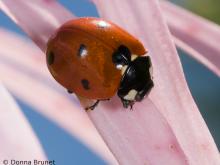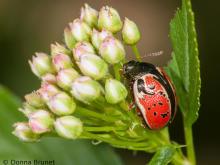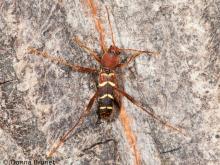Land Invertebrates
Media

Species Types
Scientific Name
Coccinella septempunctata
Description
The seven-spotted lady beetle is native to Eurasia and was introduced to our continent to combat aphid pests. It is now well established in North America.
Media

Species Types
Scientific Name
Charidotella sexpunctata
Description
The golden tortoise beetle is shiny metallic gold or orange, and the edges of the elytral shields are transparent. It eats plants in the morning glory family.
Media

Species Types
Scientific Name
Calligrapha spiraea
Description
The ninebark calligraphy beetle is one of nearly 40 North American calligraphy beetles, named for the scrawly markings on their backs. Most calligraphy beetles require particular host plants.
Media

Species Types
Scientific Name
Neoclytus acuminatus
Description
Red-headed ash borers resemble wasps, but they are harmless to people. The colors and markings are distinctive. Their larvae feed on a variety of dead or dying hardwoods, helping the decomposition process and enriching the soil.
Media

Species Types
Scientific Name
Acanthepeira stellata
Description
Mature female starbellied orbweavers spin wheel-shaped webs in prairies and other open, sunny habitats. The abdomen is decorated with a crown of spines and usually has a star pattern on the back.
Media

Species Types
Scientific Name
About 2,000 species in North America north of Mexico
Description
Plant bugs, or mirids, are a huge family of true bugs. They are often overlooked — except by gardeners and farmers. Most mirids eat plants, and some are agricultural pests. As a group, they’re an important food source for birds and other insectivores.
Media

Species Types
Scientific Name
About 300 species globally
Description
True velvet mites: You’ve probably seen these small, velvety, bright red mites creeping around on rocks, plant containers, tree trunks, or on the ground, especially after a rain. Be not afraid! They are harmless — to people.
Media

Species Types
Scientific Name
About 1,300 species in North America north of Mexico
Description
The longlegged flies are a large, diverse fly family. They often have eye-catching metallic green, copper, bronze, or blue bodies and long legs. Their delicate wings are often clear and look iridescent in bright light, but many species have dark marks near the wing tips.
Media

Species Types
Scientific Name
More than 40 species in 3 genera in North America north of Mexico
Description
Ebony bugs are definitely true bugs, but they look a lot like tiny, shiny black beetles. Their bodies are fat ovals. They’re almost always seen on flower clusters and immature seeds, often on members of the carrot or parsley family.
Media

Species Types
Scientific Name
About 175 species in North America
Description
Earthworms are familiar to just about everyone who digs in the soil. They play a major role in the nutrient cycling and structure of soils. There are many species. The most familiar ones in Missouri are nonnative.
See Also



Media

Species Types
Scientific Name
Cisseps fulvicollis
Description
The yellow-collared scape moth is more often “orange-collared.” And whether you think it looks more like a firefly or a wasp, it’s still a moth!
Media

Species Types
Scientific Name
Nearly 150 species in North America north of Mexico
Description
Slim, delicate plume moths are instantly recognizable by their T-shaped silhouette, long legs, and muted shades of tan and brown. It can be hard to separate the various species.
Media

Species Types
Scientific Name
Pyrrharctia isabella
Description
Not many people know the adult Isabella tiger moth when they see one, but we’re all acquainted with its caterpillar, the woolly worm, or woolly bear.
About Land Invertebrates in Missouri
Invertebrates are animals without backbones, including earthworms, slugs, snails, and arthropods. Arthropods—invertebrates with “jointed legs” — are a group of invertebrates that includes crayfish, shrimp, millipedes, centipedes, mites, spiders, and insects. There may be as many as 10 million species of insects alive on earth today, and they probably constitute more than 90 percent all animal species.





















